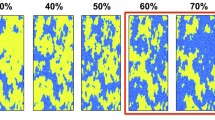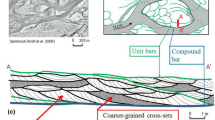Abstract
Once the injection phase of a geological carbon sequestration operation ends, capillary forces are critical for hampering the upward migration of buoyant CO2 to shallower environments. Reservoir heterogeneity is also a key factor controlling plume spreading and trapping efficiency as well as a source of uncertainty about the deep subsurface. However, these two features are typically overlooked or overly simplified by numerical models that emphasize on viscous flow driven by pressure gradients. In particular, when considering far-field regions of storage reservoirs with vanishing pressure gradients, the physics governing the CO2 flow into brine-saturated rocks become dominated by capillary and buoyancy forces. Hence, there is currently a debate on whether numerical models founded on Darcy’s law can capture some of the migration phenomena that characterize long-term CO2 migration in saline formations. In this study, we consider experimental observations from a previous physical model that illustrates flow patterns of a CO2-surrogate plume migrating through a well-characterized sand aquifer saturated with a brine-analog. Then, we compare Monte Carlo sets of invasion percolation simulations with direct observations of plume distribution to evaluate the effects of a heterogeneous capillary pressure field. The observed plume distribution appears to be controlled by a combination of buoyant migration and trapping at capillary barriers under near-hydrostatic pressure conditions. Although these observations are gathered in a simplified and relatively small laboratory system, an analogous behavior has been documented at reservoir scale for the Sleipner storage site, where a series of shale layers inhibited the buoyant migration of the plume.






Similar content being viewed by others
References
Agartan E, Trevisan L, Cihan A, Birkholzer J, Zhou Q, Illangasekare TH (2015) Experimental study on effects of geologic heterogeneity in enhancing dissolution trapping of supercritical CO2. Water Resour Res 51:1635–1648. doi:10.1002/2014wr015778
Ampomah W et al (2016) Evaluation of CO2 storage mechanisms in CO2 enhanced oil recovery sites: application to morrow sandstone reservoir. Energy Fuel 30:8545–8555
Bandilla KW, Celia MA, Birkholzer JT, Cihan A, Leister EC (2015) Multiphase modeling of geologic carbon sequestration in saline aquifers. Ground Water 53:362–377. doi:10.1111/gwat.12315
Bennion DB, Bachu S (2006) Dependence on temperature, pressure, and salinity of the IFT and relative permeability displacement characteristics of CO2 injected in deep saline aquifers. Paper presented at the 2006 SPE annual technical conference and exhibition, San Antonio
Benson SM, Cole DR (2008) CO2 sequestration in deep sedimentary formations. Elements 4:325–331. doi:10.2113/gselements.4.5.325
Berg RR (1975) Capillary pressures in stratigraphic traps. AAPG Bull Am Assoc Petrol Geol 59:939–956
Berkowitz B, Ewing RP (1998) Percolation theory and network modeling applications in soil physics. Surv Geophys 19:23–72. doi:10.1023/A:1006590500229
Bryant SL, Lakshminarasimhan S, Pope GA (2008) Buoyancy-dominated multiphase flow and its effect on geological sequestration of CO2. SPE J 13:447–454
Carruthers D (2003) Modeling of secondary petroleum migration using invasion percolation techniques. In: Marzi SDAR (ed) Multidimensional basin modeling, vol 7. AAPG/datapages discovery series, pp 21–37
Carruthers DJ, van Wijngaarden MD (2000) Modelling viscous-dominated fluid transport using modified invasion percolation techniques. J Geochem Explor 69:669–672. doi:10.1016/S0375-6742
Cavanagh AJ, Haszeldine RS (2014) The Sleipner storage site: capillary flow modeling of a layered CO2 plume requires fractured shale barriers within the Utsira Formation. Int J Greenh Gas Control 21:101–112. doi:10.1016/j.ijggc.2013.11.017
Cavanagh A, Rostron B (2013) High-resolution simulations of migration pathways and the related potential well risk at the IEAGHG Weyburn–Midale CO2 storage project. Int J Greenh Gas Control 16:S15–S24
Cavanagh A, Haszeldine RS, Nazarian B (2015) The Sleipner CO2 storage site: using a basin model to understand reservoir simulations of plume dynamics. First Break 33:61–68
Chandler R, Koplik J, Lerman K, Willemsen JF (1982) Capillary displacement and percolation in porous-media. J Fluid Mech 119:249–267. doi:10.1017/S0022112082001335
Cinar Y, Riaz A, Tchelepi HA (2009) Experimental study of CO2 injection into saline formations. SPE J 14:588–594
Corradi A, Ruffo P, Corrao A, Visentin C (2009) 3D hydrocarbon migration by percolation technique in an alternate sand–shale environment described by a seismic facies classified volume. Mar Petrol Geol 26:495–503. doi:10.1016/j.marpetgeo.2009.01.002
Dai Z et al (2016) CO2 accounting and risk analysis for CO2 sequestration at enhanced oil recovery sites. Environ Sci Technol 50:7546–7554
England WA, Mackenzie AS, Mann DM, Quigley TM (1987) The movement and entrapment of petroleum fluids in the subsurface. J Geol Soc Lond 144:327–347. doi:10.1144/gsjgs.144.2.0327
Farajzadeh R, Ranganathan P, Zitha PLJ, Bruining J (2011) The effect of heterogeneity on the character of density-driven natural convection of CO2 overlying a brine layer. Adv Water Resour 34:327–339. doi:10.1016/j.advwatres.2010.12.012
Frette V, Feder J, Jossang T, Meakin P (1992) Buoyancy-driven fluid migration in porous-media. Phys Rev Lett 68:3164–3167. doi:10.1103/PhysRevLett.68.3164
Gershenzon NI, Ritzi RW, Dominic DF, Soltanian M, Mehnert E, Okwen RT (2015) Influence of small-scale fluvial architecture on CO2 trapping processes in deep brine reservoirs. Water Resour Res 51:8240–8256. doi:10.1002/2015wr017638
Glass RJ, Yarrington L (2003) Mechanistic modeling of fingering, nonmonotonicity, fragmentation, and pulsation within gravity/buoyant destabilized two‐phase/unsaturated flow. Water Resour Res 39:1058. doi:10.1029/2002WR001542
Glass RJ, Conrad SH, Peplinski W (2000) Gravity-destabilized nonwetting phase invasion in macroheterogeneous porous media: experimental observations of invasion dynamics and scale analysis. Water Resour Res 36:3121–3137. doi:10.1029/2000wr900152
Glass RJ, Conrad SH, Yarrington L (2001) Gravity-destabilized nonwetting phase invasion in macroheterogeneous porous media: near-pore-scale macro modified invasion percolation simulation of experiments. Water Resour Res 37:1197–1207. doi:10.1029/2000wr900294
Ioannidis MA, Chatzis I, Dullien FAL (1996) Macroscopic percolation model of immiscible displacement: effects of buoyancy and spatial structure. Water Resour Res 32:3297–3310. doi:10.1029/95wr02216
IPCC (2005) IPCC special report on carbon dioxide capture and storage. In: Intergovernmental panel on climate change. Cambridge University Press, Cambridge
Islam A, Chevalier S, Ben Salem I, Bernabe Y, Juanes R, Sassi M (2014) Characterization of the crossover from capillary invasion to viscous fingering to fracturing during drainage in a vertical 2D porous medium. Int J Multiph Flow 58:279–291. doi:10.1016/j.ijmultiphaseflow.2013.10.002
Knackstedt MA, Paterson L (2009) Invasion percolation. In: Meyers AR (ed) Encyclopedia of complexity and systems science. Springer, New York, pp 4947–4960. doi:10.1007/978-0-387-30440-3_294
Kueper BH, McWhorter DB (1992) The use of macroscopic percolation theory to construct large-scale capillary pressure curves. Water Resour Res 28:2425–2436
Lenormand R, Touboul E, Zarcone C (1988) Numerical-models and experiments on immiscible displacements in porous-media. J Fluid Mech 189:165–187
Meakin P, Feder J, Frette V, Jo T (1992) Invasion percolation in a destabilizing gradient. Phys Rev A 46:3357
Meakin P, Wagner G, Vedvik A, Amundsen H, Feder J, Jøssang T (2000) Invasion percolation and secondary migration: experiments and simulations. Mar Petrol Geol 17:777–795. doi:10.1016/s0264-8172(99)00069-0
Meckel TA, Bryant SL, Ganesh PR (2015) Characterization and prediction of CO2 saturation resulting from modeling buoyant fluid migration in 2D heterogeneous geologic fabrics. Int J Greenh Gas Control 34:85–96. doi:10.1016/j.ijggc.2014.12.010
Mikes D, Bruining J (2006) Standard flow cells to incorporate small-scale heterogeneity (crossbedding) in a reservoir model. Mar Petrol Geol 23:979–993. doi:10.1016/j.marpetgeo.2005.06.004
Mumford KG, Hegele PR, Vandenberg GP (2015) Comparison of two-dimensional and three-dimensional macroscopic invasion percolation simulations with laboratory experiments of gas bubble flow in homogeneous sands. Vadose Zone J. doi:10.2136/vzj2015.02.0028
Oldenburg CM, Mukhopadhyay S, Cihan A (2015) On the use of Darcy’s law and invasion-percolation approaches for modeling large-scale geologic carbon sequestration. Greenh Gases Sci Technol 6:19–33. doi:10.1002/ghg.1564
Pentland CH, Itsekiri E, Al Mansoori SK, Iglauer S, Bijeljic B, Blunt MJ (2010) Measurement of nonwetting-phase trapping in sandpacks. SPE J 15:274–281
Pickup G, Ringrose PS, Sharif A (2000) Steady-state upscaling: from lamina-scale to full-field model. SPE J. doi:10.2118/62811-pa
Polak S, Cinar Y, Holt T, Torsaeter O (2015) Use of low- and high-IFT fluid systems in experimental and numerical modelling of systems that mimic CO2 storage in deep saline formations. J Petrol Sci Eng 129:97–109. doi:10.1016/j.petrol.2015.02.031
Ringrose PS, Sorbie KS, Corbett PWM, Jensen JL (1993) Immiscible flow behaviour in laminated and cross-bedded sandstones. J Petrol Sci Eng 9:103–124. doi:10.1016/0920-4105(93)90071-L
Singh V, Cavanagh A, Hansen H, Nazarian B, Iding M, Ringrose P (2010) Reservoir modeling of CO2 plume behavior calibrated against monitoring data from Sleipner, Norway. Paper presented at the SPE annual technical conference and exhibition, Florence, 19–22 Sept 2010
Soltanian MR, Amooie MA, Dai Z, Cole D, Moortgat J (2016) Critical dynamics of gravito-convective mixing in geological carbon sequestration. Sci Rep 6:35921. doi:10.1038/srep35921
Toussaint R, Måløy KJ, Méheust Y, Løvoll G, Jankov M, Schäfer G, Schmittbuhl J (2012) Two-phase flow: structure, upscaling, and consequences for macroscopic transport properties. Vadose Zone J. doi:10.2136/vzj2011.0123
Trevisan L et al (2014) Investigation of mechanisms of supercritical CO2 trapping in deep saline reservoirs using surrogate fluids at ambient laboratory conditions. Int J Greenh Gas Control 29:35–49. doi:10.1016/j.ijggc.2014.07.012
Trevisan L, Pini R, Cihan A, Birkholzer JT, Zhou Q, Illangasekare TH (2015) Experimental analysis of spatial correlation effects on capillary trapping of supercritical CO2 at the intermediate laboratory scale in heterogeneous porous media. Water Resour Res 51:8791–8805. doi:10.1002/2015wr017440
Trevisan L, Krishnamurthy PG, Meckel TA (2017a) Impact of 3D capillary heterogeneity and bedform architecture at the sub-meter scale on CO2 saturation for buoyant flow in clastic aquifers. Int J Greenh Gas Control 56:237–249. doi:10.1016/j.ijggc.2016.12.001
Trevisan L, Pini R, Cihan A, Birkholzer JT, Zhou Q, González-Nicolás A, Illangasekare TH (2017b) Imaging and quantification of spreading and trapping of carbon dioxide in saline aquifers using meter-scale laboratory experiments. Water Resour Res 53:485–502
van Lingen PP, Bruining J, van Kruijsdijk CPJW (1996) Capillary entrapment caused by small-scale wettability heterogeneities. SPE Reserv Eng 11:93–100. doi:10.2118/30782-pa
Vasseur G, Luo X, Yan J, Loggia D, Toussaint R, Schmittbuhl J (2013) Flow regime associated with vertical secondary migration. Mar Petrol Geol 45:150–158. doi:10.1016/j.marpetgeo.2013.04.020
Werner M et al (2014) A physical model for geological CO2 storage—replacing misconceptions by visual explanation. Int J Greenh Gas Control 25:42–53. doi:10.1016/j.ijggc.2014.03.014
Wilkinson D, Willemsen JF (1983) Invasion percolation—a new form of percolation theory. J Phys A Math Gen 16:3365–3376. doi:10.1088/0305-4470/16/14/028
Yang Z, Tian L, Niemi A, Fagerlund F (2013) Upscaling of the constitutive relationships for CO2 migration in multimodal heterogeneous formations. Int J Greenh Gas Control 19:743–755. doi:10.1016/j.ijggc.2012.11.015
Zhao BZ, MacMinn CW, Huppert HE, Juanes R (2014) Capillary pinning and blunting of immiscible gravity currents in porous media. Water Resour Res 50:7067–7081. doi:10.1002/2014wr015335
Acknowledgements
Funding for performing invasion percolation simulations was provided by the Center for Frontiers of Subsurface Energy Security, an Energy Frontier Research Center funded by the US Department of Energy, Office of Science, Basic Energy Sciences under Award # DE-SC0001114. The experimental work was supported by the US Department of Energy through the National Energy Technology Laboratory’s CO2 sequestration R&D Program under Grant DE-FE0004630 and National Science Foundation Award #: EAR-1045282 through the Hydrologic Sciences Program. The authors thank Steven Bryant and three anonymous reviewers for insightful observations and LT acknowledges additional funding from the Bureau of Economic Geology.
Author information
Authors and Affiliations
Corresponding author
Rights and permissions
About this article
Cite this article
Trevisan, L., Illangasekare, T.H. & Meckel, T.A. Modelling plume behavior through a heterogeneous sand pack using a commercial invasion percolation model. Geomech. Geophys. Geo-energ. Geo-resour. 3, 327–337 (2017). https://doi.org/10.1007/s40948-017-0055-5
Received:
Accepted:
Published:
Issue Date:
DOI: https://doi.org/10.1007/s40948-017-0055-5




